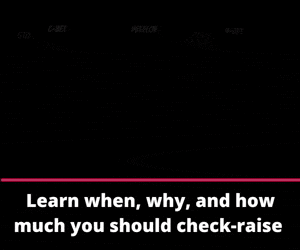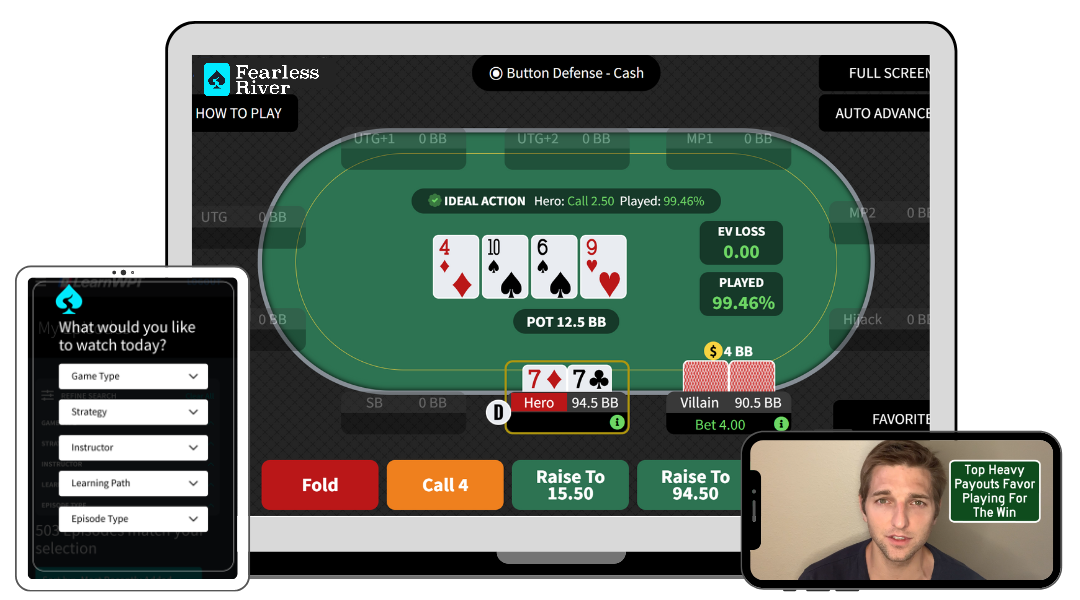Poker Quiz! Q♦Q♠ Facing a Flop Check-Raise, What Do You Do?
DECISION POINT: In your first hand at a live $1/$3 cash game action folds to a Middle Position player who limps and you raise to $18 from the Hijack with Q♦Q♠. It folds to the Small Blind who calls and the original limper also folds. The Small Blind checks the Q♣8♣2♣ flop, you bet $15, your opponent raises to $30, and action is back on you.
What do you do here?
PRO ANSWER: We are playing our first hand at a $1/$3 cash game with most players having around $300. The session is starting off well as we get dealt QdQc on the first hand. Action folds to MP1 who just limps, MP2 folds, and it’s our turn to act in the Hijack.
The isolation raise vs a limper is your normal first-in amount with no action in front, plus one big blind for the limper. Often in these lower stakes live cash games it’s necessary to raise to 5BBs or larger to appropriately thin the field, so in this scenario we make it $18. Everyone folds to the Small Blind who cold calls or raise, and the Big Blind and original limper in MP1 both fold.
The flop is Qc8c2c. Monotone boards are very tricky. Sometimes our first instinct is to fire big here to prevent opponents from being able to profitably call with a single club in their hand. By choosing a larger sizing we limit the ability to get value from worse hands. When an opponent continues vs this larger sizing it becomes more likely that they have a very strong hand.
On monotone boards we can often bet much smaller and still accomplish our goals, even as little as 20% of the pot. We bet $15, which is probably a little larger than necessary but still in the right ballpark, and our opponent minimum raises to $30.
One of the first steps in evaluating our best approach to this min-raise is to consider the best case and worst case scenarios. Our worst case is that the Small Blind already has a flush meaning we have 7 outs to fill up (or hit quads) on the turn, and 10 outs on the river. That gives us around 33% equity in the pot. It’s not ideal to be all-in here with 33% equity, but as far as worst case scenarios we are not drawing dead.
Continued below ...
The best case is the Small Blind has flopped a set with 88 or 22 and we just have them absolutely crushed with almost 95% equity. A plausible middle scenario is that they have the Ace of clubs with a non-club kicker or a Qx combo with a club kicker, so we can assume the Small Blind has 9 outs to make a flush on the turn.
In the instance our opponent does turn a flush we have a 10 out redraw. When the turn does not improve the Small Blind to a flush they will have 8 outs on the river, as one of their club outs will give us a winning full house. In the best case scenario we have approximately 70% equity which is still very strong.
Ultimately our decision here comes down to what our opponent’s range looks like. If the Small Blind would ONLY ever min-raise back flushes on this monotone board, then you have the pot odds plus implied odds to call. With no specific reads we have to assume that our opponent is capable of making this play with a somewhat balanced range that includes hands noted in our best case scenario.
We have a tremendous amount of equity against these AcXx and QxKc hands and we are happy to start pushing equity immediately. So without a confirmed player specific read that Small Blind will make this small raise with a flush and ONLY a flush in this spot, re-raising here to push our equity is best.
Reraising is the best play.
How would you play it?
Share your answer in the comments below!
Improve Your Game Today!
Join LearnWPT and Get:
- The WPT GTO Trainer to play real solved hands and get instant feedback on YOUR leaks (over 4 BILLION solved spots!)
- On-demand access to our full library of 500+ (and growing) in-depth Strategy Episodes from world-class players
- All of your poker questions answered with the Ask a Pro Feature
- Expert analysis from LearnWPT Pros using The Hand Input Tool
- Downloadable Tools you can use at and away from the tables
- Learn from a Team of world-class Professional Players
To join (just $5 your 1st month) click the JOIN NOW button and start improving your game!
Have Questions about LearnWPT? Email us at [email protected].


